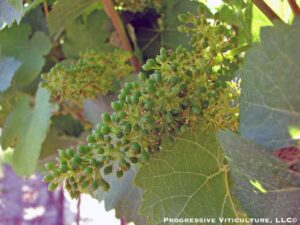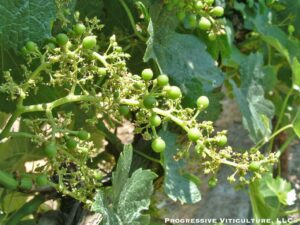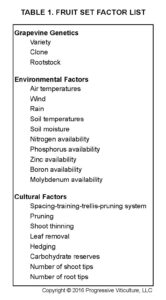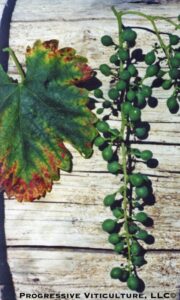MONDAY, MAY 20, 2016. BY STAN GRANT, VITICULTURIST.
Fruit set is the process in which flowers become fruit and potential fruit size is determined. It occurs after pollen is released from male flower parts (anthers), lands on receptive female flower parts (stigmas), produces a tube that grows to the ovules, and fertilizes eggs contained in them. Fertilized eggs form seeds, which induce surrounding (pericarp) tissues to grow and form a berry. The size of the berry will be closely correlated with the number of seeds that form within it, which may reach a maximum of four.
It is normal for a large portion of flowers (> 50 %) to fail and fall, even under optimum conditions (fig 1).
Unusually high rates of fruit set failure, which markedly decrease yields and economic returns, are an obvious concern for wine grape growers. Poor fruit set may be the result of grapevine genetics, environmental conditions, and/or cultural practices (fig 2, table 1). It can take one of two forms: a mixture of normal and undersized berries (millerandage) and a failure to set berries (coulure).
Environmental conditions before, during, and after bloom may have an impact on fruit set. Warm, dry conditions encourage fruit set, while extremes in temperature and soil moisture diminish it. Excessive rainfall and high winds are also disruptive.
Excess growth vigor from training-trellis-spacing-pruning systems undersized for their sites or excess available nitrogen can diminish fruit set. On the other hand, very low growth vigor due to disease, low carbohydrate reserves, low nitrogen, and unfavorable growing conditions can also diminish fruit set.
Hedging or leaf removal before, during, and after bloom may induce poor fruit set. These canopy management practices reduce photosynthesis and the flow of carbohydrates to the flowers and new fruit. Defoliation may also reduce the number of flowers developing in buds, effectively reducing next years crop.
An adequate and balanced supply of all mineral nutrients is critical for optimum fruit set. However, certain mineral nutrients, including phosphorus, boron, zinc, and molybdenum, effect fruit set directly because they have various roles in pollen development, pollen viability, pollen germination, and pollen tube growth (fig 3).
Even when soil and tissue levels appear adequate, the supply of these nutrients coming from the roots is often insufficient to satisfy the high transient demand during bloom. As a result, clusters usually benefit from supplemental fertilizer nutrients applied to the foliage immediately before or during bloom.
Certain rootstocks, such as St. George and Dogridge, consistently reduce fruit set, while others may enhance set compared to own-rooted vines, including 420A, Schwarzmann, and 1616C. Certain clones also set fewer berries than others. For example, Cabernet Sauvignon clone 06 sets less fruit than most other clones because it produces defective pollen. Some wine grape varieties, regardless of clone, are prone to poor fruit set. Three of the best-known examples are Merlot, Malbec, and Muscat of Alexandra. Poor set in Merlot is particularly important to the wine industry because it is major variety, representing about 6.5 % of the 2015 crush.
Possible causes of low fruit set in Merlot include the following. Merlot produces many lateral shoots and the tips of these shoots are resource sinks that may out compete clusters. It is also possible that Merlot is unable to translocate sufficient quantities of nutrients from the roots. Merlot may be prone to accumulations of nitrate in cluster tissues sufficient to disrupt fruit set.
Fruit set has been an active area of research since about 1960 and Mid Valley Agricultural Services joined the effort in 2006 with a Merlot field trial conducted in the Lodi area. They evaluated both cultural and chemical treatments, including fertilizers and growth stimulants. They confirmed that lateral removal and shoot tipping improve fruit set. Both are labor intensive and unlikely to be widely adopted. We also demonstrated that molybdenum is nearly as effective as the two cultural practices and substantially less expensive.
Currently, the best vineyard management strategy for optimized fruit set involves the following. After harvest, ensure vines go dormant with moist soil around their roots and maintain moisture in the upper root zone over the winter. Early in the season, maintain a soil environment that is moist, but not saturated. Prune near or during budbreak, when the majority of the buds are fully developed and active. Practice balanced soil fertility management throughout the growing season. Thin shoots well in advance of bloom to minimize competition and direct resources into the shoots that will be retained. Immediately prior to or during bloom, apply foliar fertilizers containing phosphorus, boron, zinc, and molybdenum unless the soils are very high in these nutrients. Finally, if warranted by economics, tip shoots early in the bloom period.
This article was originally published in the Mid Valley Agricultural Services October 2006 newsletter.
Further Reading
Alexander, DMcE, Woodham, RC. Yield responses by Sultanas to applications of zinc and superphosphate. Aust. J. Exp. Agric. Animal. Husb. 16, 817-823. 1965.
Aziz, A, Brun, O, Audran, J-C. Involvement of polyamines in the control of fruitlet physiological abscission in grapevines (Vitis vinifera). Physiologia Planatarum. 113, 50-58. 2001.
Bennet, J. Trought, MCT, Jarvis, P. The importance of over-wintering carbohydrates on inflorescence development and yield potential. Aust. Grapegrower Winemaker. 456, 70-72. 2002.
Bowen, PA, Kliewer, WM. Influence of clonal variation, pruning severity, and cane structure on yield component development in ‘Cabernet Sauvignon’ grapevines. J. Amer. Soc. Hort. Sci. 115, 530-534. 1990.
Brown, K, Jackson, DI, Steans, GF. Effects of chlormequat, girdling, and tipping on berry set in Vitis vinifera L. Am. J. Enol. Vitic. 39, 91-94. 1988.
Brown, PH. Nutrient demand and fertilizer strategies: lessons learned from boron. In Conf. Proc. Calif. Plant Soil Conf., Modesto, Calif., Feb. 5-6, 2003. Calif. Chapt. Am. Soc. Agron. 2003.
Coombe, BG. Fruit set and development in seeded grape varieties as affected by defoliation, tipping, girdling, and other treatments. Am. J. Enol. Vitic. 10, 85-100. 1959.
Coombe, BG. The effect of removing leaves, flowers, and shoot tips on fruit in Vitis vinifera L. J. Hort. Sci. 37, 1-15. 1962.
Coombe, BG. Effects of growth retardants on Vitis vinifera. Vitis. 6, 278-287. 1965.
Coombe, BG. Increase fruit set of Vitis vinifera by treatment with growth retardants. Nature. 205, 305-306. 1965.
Coombe, BG. Effects of growth retardants on Vitis vinifera. Vitis. 6, 278-287. 1967.
Coombe, BG. Fruit set in grape vines: the mechanism of the CCC effect. J. Hort. Sci. 45, 415-425. 1970.
Ewart, AJW, Kliewer, WM. Effects of controlled day and night temperatures and nitrogen on fruit-set, ovule fertility, and fruit composition of several wine grape cultivars. Am. J. Enol. Vitic. 28, 88-95. 1977.
Friend, AP, Trought, MCT, Creasy, GL. Pruning to increase yield: The influence of delayed pruning time on yield components of Vitis vinifera L. cv. Merlot. In: 5th Intl. Symp. Cool Climate Vitic. Oenol, Melborne. (unpublished).
Galet, P. General Viticulture. Oneoplurimedia, Chateau de Chaintre, France, 2000.
Glad, C, Farineau, J, Regnard, J-L, Morot-Gaudry, J-F. The relative contribution of nitrogen originating from two seasonal 15N supplies to the total nitrogen pool present in the bleeding sap and in whole Vitis vinifera cv. Pinot Noir grapevines at bloom time. Am. J. Enol. Vitic. 45, 327-332. 1994.
Guerra, B. Tipping Malbec shoots to improve set and yield. Practical Winery and Vineyard. Jan/Feb. 2006.
Hewitt, WB, Jacob, HE. Effect of zinc on yield and cluster weight in Muscat grapes. Proc. Am. Soc. Hort. Sci. 46, 256-262.
Keller, M. The science of grapevines. Academic Press, Burlington, MA. 2010.
Kliewer, WM. Effect of root temperatures on budbreak, shoot growth, and fruit-set of ‘Cabernet Sauvignon’ grapevines. Am. J. Enol. Vitic. 26,82-89. 1975.
Kliewer, WM. Effect of high temperatures during the bloom-set period on fruit set, ovule fertility, and berry growth of several grape cultivars. Am. J. Enol. Vitic. 28, 215-222. 1977.
Lebon, G, Magne, C, Brun, O, Clement, C. Carbohydrate content of inflorescences of grapevine (Vitis vinifera L.) and sexual structure development in relation with flower and fruit drop. Abstrct In Williams, LE (ed.) Proc. 7th Int. Symp. Grapevine Physio. Biotech. Davis, Calif. 21-25Jan2004.
May, P. Flowering and fruit set in grapevines. Lythrum Press, Adelaide. 2004.
Mullins, MG. Regulation of fruit set in the grape vine. Aust. J. Biol. Sci. 20, 1141-1147. 1967.
Natio, R, Fujimoto, J, Yamamura, H. Effects of shoot vigor and SADH application to clusters before anthesis on berry set in Kyoho grapes. Am. J. Enol. Vitic. 34, 142-147. 1983.
Peterson, JR. Effect of N-dimethylaminosuccinamic acid on Cabernet Sauvignon grapevines. Aust. J. Exp. Agric. and An. Husb. 14, 126-128. 1974.
Skene, KGM. A comparison of the effects of “Cycocel” and tipping on fruit set in Vitis vinifera L. Aust. J. Biol. Sci. 22, 1305-1311. 1969.
Skinner, PW, Matthews, MA. Reproductive development in grape (Vitis vinifera L.) under phosphorus limited conditions. Sci. Hortic. 38:49-60 (1989).
Smith, TA. Plant polyamines – Metabolism and function. In Polyamines and Ethylene; Biochemistry, Physiology, and Interactions. Current topics in Plant Physiology Series 5. Flores, HE, Arteca, RN, Shannon, JC. Am. Soc. Plant Physiologists, Rockville, MA. 1990.
Swain, SM, Muller, A. Plant hormones in relation to ‘hen and chicken’ disorder. Aust. New Zealand Grapegrower Winemaker. 474, 35, 38-39. 2003.
Vasconcelos, MC, Castagnoli, S. Leaf canopy structure and vine performance. Am. J. Enol. Vitic. 51, 390-396. 2000.
Winkler, AJ. The influence of pruning on the germinability of pollen and the set of berries in Vitis vinifera. Hilgardia. 2, 107-124. 1926.
Winker, AJ, Cook, JA, Kliewer, MK, Lider, LA. General Viticulture. UC Press, Berkeley. 1974.
Wolf, TK. Responses of young Chardonnay grapevines to shoot tipping, Ethephon, and basal leaf removal. Am. J. Enol. Vitic. 37, 263-268. 1986.
Zapata, C, Magne, C., Deleens, E, Brun, O, Audran, J-C, Chaillou, S. Grapevine culture in trenches, root growth and dry matter portioning. Aust. J. Grape Wine Res. 7, 127-131. 2001.





